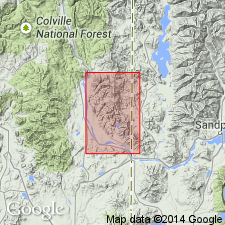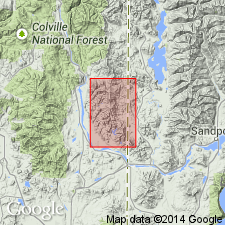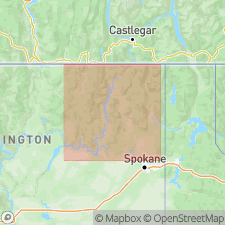- Usage in publication:
-
- Pend Oreille Valley andesite
- Modifications:
-
- Original reference
- Dominant lithology:
-
- Andesite
- AAPG geologic province:
-
- Northern Cascade Range-Okanagan province
Schroeder, M.C., 1949, The Tertiary rocks of southern Pend Oreille County, Washington [abs.]: Northwest Science, v. 23, no. 1, p. 39-40.
Summary:
Pend Oreille Valley andesite proposed for volcanics consisting of valley flows
of dark-gray trachytic andesite.
Source: US geologic names lexicon (USGS Bull. 1200, p. 2976-2977).

- Usage in publication:
-
- Pend Oreille andesite
- Modifications:
-
- Principal reference
- Dominant lithology:
-
- Andesite
- AAPG geologic province:
-
- Northern Cascade Range-Okanagan province
Summary:
Pg. 7 (table), 24-25, pl. 1. Pend Oreille andesite. Dark-gray trachitic hornblende andesite. Occurs as flows in an old valley that has been cut into the metamorphics of Newport group (new). Thickness about 1,100 feet. North of Skookum Creek unconformably underlies Tiger formation. Age is Miocene(?).
Named from its occurrence within the valley of the Pend Oreille River, Pend Oreille Co., northeastern WA. Crops out 1.5 mi north of Furport along eastern edge of Pend Oreille River valley and forms valley wall for distance of 7 mi to Skookum Creek valley near the State Fish Hatchery, [Skookum Creek 7.5-min quadrangle], Pend Oreille Co., northeastern WA.
Source: Publication; US geologic names lexicon (USGS Bull. 1200, p. 2976-2977).

- Usage in publication:
-
- Pend Oreille Andesite*
- Modifications:
-
- Principal reference
- Geochronologic dating
- Age modified
- Adopted
- Dominant lithology:
-
- Andesite
- AAPG geologic province:
-
- Northern Cascade Range-Okanagan province
Summary:
Pg. 4-5 (pamphlet), geol. map. Pend Oreille Andesite. Flows, flow breccias, and locally, thin interflow sedimentary rocks. Flow rock and breccia are massive (contain almost no internal layering), light-gray to pinkish gray and invariably contain phenocrysts of hornblende and biotite from 0.05 to 0.2 inch in length. Age is considered Eocene. Samples collected by R.C. Pearson from near center sec. 27, T. 33 N., R. 44 E., [Skookum Creek 7.5-min quadrangle, Pend Oreille Co., northeastern WA], yielded K-Ar ages of 51.0 Ma (hornblende) and 50.4 Ma (biotite), citing J.D. Obradovich, USGS. Type locality designated. (Pend Oreille Andesite adopted by the USGS.)
Type locality: 1.5 mi north of Furport along eastern edge of Pend Oreille River valley, [Skookum Creek 7.5-min quadrangle], Pend Oreille Co., northeastern WA.
Source: Publication.

- Usage in publication:
-
- Pend Oreille Andesite†
- Modifications:
-
- Abandoned
- AAPG geologic province:
-
- Northern Cascade Range-Okanagan province
Summary:
†Pend Oreille Andesite abandoned; its rocks now included in Sanpoil Volcanics.
Source: Changes in stratigraphic nomenclature, 1977 (USGS Bull. 1457-A, p. A57-A58), GNC index card files.
For more information, please contact Nancy Stamm, Geologic Names Committee Secretary.
Asterisk (*) indicates published by U.S. Geological Survey authors.
"No current usage" (†) implies that a name has been abandoned or has fallen into disuse. Former usage and, if known, replacement name given in parentheses ( ).
Slash (/) indicates name conflicts with nomenclatural guidelines (CSN, 1933; ACSN, 1961, 1970; NACSN, 1983, 2005, 2021). May be explained within brackets ([ ]).

